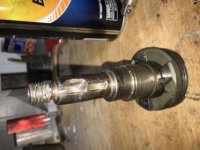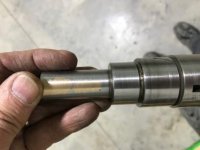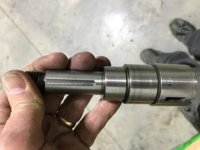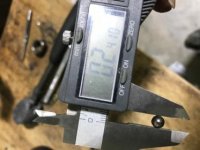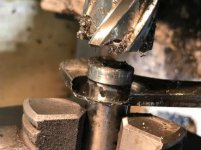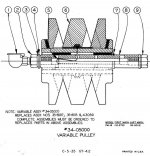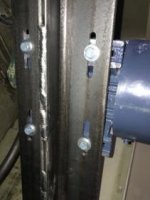Hi folks, I’ve recently acquired a 1957 DoAll 16-SFP vertical bandsaw and have been reading and re-reading posts on this forum on rebuilds of old Doall saws. In my case the saw looked good from pics but as you might expect a pretty coat of paint can be deceiving. It ran but jerked and bucked like crazy so the investigation began. Top band wheel looked good and turned smooth. Bottom wheel was another matter! It had lots of slop so off it came. What I found was disappointing. Here is pic of the input shaft (after I removed it from tranny.

The woodruff key was gone but someone had hand drilled into the shaft and tried to thread for a set Screw!! Needless to say it was not successful! This brings me to my first question. I can tig weld the shaft to build it back up and turn it to size plus fix the thread and recut the key way but I don’t know the steel formulation so worry a bit about it getting to hard and I will have trouble cutting with HSS. Any advice?
While we are on this shaft...the bronze bushing has about .015” clearance (shaft dia is 0.748”) so I’ll rebush this. Second question is why the slots are cut into this shaft and bushing? I don’t see any key that this slot engages so wondered why it is there! Here is pic
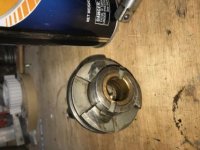
Ok on to the bandwheel. There was a steel bushing in the center of the Aluminum bandwheel. Is this original or was it a repair? It came out with some heat and light pressing and the bore of the Aluminum looks good so making another steel bushing should be easy. I hope if it was a repair that they did a good job getting it centered! Pic of wheel and bushing:

Now some transmission issues/questions. The tranny came apart easily...in fact too easily. The bearings were not tight in the case to the point that if a bearing started to bind the bearing outer race would have spun. Anyone recommend the best way to correct this when I get around to putting it back together?
Next the variable speed pulleys (I think they are called Reeves!). They don’t look too bad but I’m not sure they were installed correctly and looking at the parts diagram I can’t determine. The pulley assembly on one end is flush while on the other end is counterbored. Which end faces the snap ring?

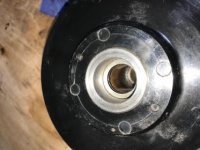
Many more questions soon
Thx Dan

The woodruff key was gone but someone had hand drilled into the shaft and tried to thread for a set Screw!! Needless to say it was not successful! This brings me to my first question. I can tig weld the shaft to build it back up and turn it to size plus fix the thread and recut the key way but I don’t know the steel formulation so worry a bit about it getting to hard and I will have trouble cutting with HSS. Any advice?
While we are on this shaft...the bronze bushing has about .015” clearance (shaft dia is 0.748”) so I’ll rebush this. Second question is why the slots are cut into this shaft and bushing? I don’t see any key that this slot engages so wondered why it is there! Here is pic

Ok on to the bandwheel. There was a steel bushing in the center of the Aluminum bandwheel. Is this original or was it a repair? It came out with some heat and light pressing and the bore of the Aluminum looks good so making another steel bushing should be easy. I hope if it was a repair that they did a good job getting it centered! Pic of wheel and bushing:

Now some transmission issues/questions. The tranny came apart easily...in fact too easily. The bearings were not tight in the case to the point that if a bearing started to bind the bearing outer race would have spun. Anyone recommend the best way to correct this when I get around to putting it back together?
Next the variable speed pulleys (I think they are called Reeves!). They don’t look too bad but I’m not sure they were installed correctly and looking at the parts diagram I can’t determine. The pulley assembly on one end is flush while on the other end is counterbored. Which end faces the snap ring?


Many more questions soon
Thx Dan


